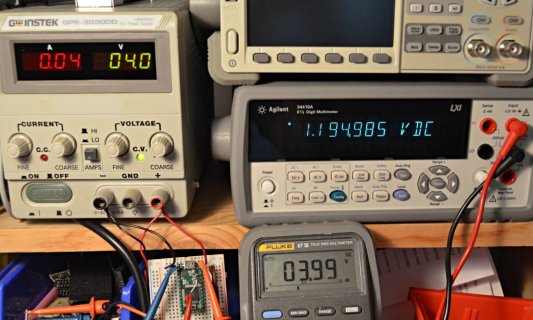As Jp 3141 stated, its about 2 counts in a 10bit adc conversion when going down from 5V to 4V so if the USB voltage differ 5% of 5V its 0,25V or so, it should be quite a inpact when reading with 16bit.
Could a way to overcome this be to simply use a voltage devider to get around 3.2V and feed vref (removeing the 400ish ohm pullup on the teensy board), the voltage devider is feed via the same powersorce (probobly a LM7808)
As the measurements showed, the ARF(ext) changes somewhat (10mV) when the input voltage changes a lot (1.4V). That ratio of input voltage change to output voltage change is called Power Supply Rejection Ratio (PSRR). Here, the PSRR is 0.7%.
Notice that then the input voltage falls below a certain minimum, the regulation is lost. That happens in the last measurement, we get a 400mV change for a change in input of 1.8V (PSRR = 22%)
The PSRR of a voltage divider is very poor - for example a 1:1 divider has a PSRR of 50% - change the input by one volt and the output at the junction of ther two resistors changes by 0.5V (the ratio of the risistors in the divider).
In contrast, the AREF(int) changed by 12μV (0.000012V) when the input changed by 1.8V. That is a PSRR of 0.00067%. The internal reference is created by a specialized circuit called a voltage reference, which is designed to have a very high PSRR (and also a high rejection of changes in response to load, over some fairly small load range).
If you want better PSRR than AREF(ext) and the voltage provided by AREF(int) is not suitable, you have a couple of options. One is to use an extra ADC channel to simply read AREF, or better, to read AREF/2. That allows you to scale your other ADC readings to a constant AREF.
Another option is to use a voltage regulator (such as the LM7808) as a voltage reference, as you suggest. However, a voltage regulator is less stable than a voltage reference. It usually has worse PSRR and worse drift over temperature. (It can typically supply a lot more current, athough the voltage does change a bit with increasing current - this is Load Regulation).
A third option is an external voltage reference chip to provide a stable voltage with high PSRR. These chips are available with a range of voltages - 5, 4.096, 3.3, 3.0, 2.5 and 2.048 are commonly available. Fior circuitry that draws little current, you can use these directly as miniature power supplies. For slightly higher current, an op-amp buffer on the voltage reference output helps.


